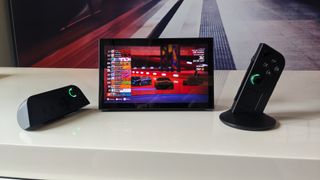AMD is helping to usher in the second generation of PC gaming handhelds in 2025 with the announcement of the AMD Ryzen Z2 series of processors, designed to provide more performance and better efficiency for PC gaming handhelds like the Steam Deck, Asus ROG Ally, and Lenovo Legion Go.
Coming in three different tiers, the AMD Ryzen Z2 processors will include the Ryzen Z2 Extreme, AMD Ryzen Z2, and AMD Ryzen Z2 Go. The Ryzen Z2 Extreme will feature eight cores and 16 threads, a 5.0GHz boost clock, 24MB cache, 16 RDNA 3.5 GPU cores, and a 15W-35W power envelope.
The Ryzen Z2 will also feature eight cores and 16 threads, but with a slightly higher 5.1GHz boost clock, the same 24MB cache, but 12 RDNA 3.5 GPU cores rather than 16, and a slightly smaller 15W-30W power envelope.
The new Ryzen Z2 Go (which had no equivalent with the Ryzen Z1 series), will have four cores and eight threads, a 4.3GHz boost clock, and 10MB cache, but the same 12 GPU cores and 15W-30W power envelope as the Ryzen Z2.
As the chips won’t sell on their own, there’s no hard release date, as that’ll depend on the release dates for the individual handhelds, but handhelds featuring the new chips should be available starting in Q1 2025.
Swipe to scroll horizontally
| Cores | 4 | 8 | 8 |
| Threads | 8 | 16 | 16 |
| Base Frequency (GHz) | 3.0 | 3.3 | 2.0 |
| Boost Frequency (Ghz) | 4.3 | 5.1 | 5.0 |
| Total Cache (MB) | 10 | 24 | 24 |
| Graphics | RDNA 2 | RDNA 3 | RDNA 3.5 |
| TDP (W) | 15-30 | 15-30 | 15-35 |
Adding fuel to an already red-hot PC gaming handheld market
Following the launch of the Steam Deck in 2022, the PC gaming handheld market has exploded over the past two years, with nearly every major gaming PC manufacturer producing their own PC gaming handheld.
With few exceptions, these have all run on the AMD Ryzen Z1 series processors, so it’s natural that about two years after the launch of the Asus ROG Ally, the second PC gaming handheld after the Steam Deck, the AMD Ryzen Z-series SoCs would get a refresh with some new architecture and design.
And while the Ryzen Z1 has essentially had the entire market to itself, Intel’s strong showing with the MSI Claw 8 AI+, the first handheld to feature an Intel Lunar Lake SoC, has definitely injected a good deal more competition into this space.
We haven’t been able to test the new chis yet, so we can’t say yet whether the new chips are worth an upgrade, but given the popularity of these handhelds, it’s good to see AMD not just commit itself to further Z-series development, but even expanding it into a lower ‘budget’ specced tier which will hopefully help bring the cost of future PC gaming handhelds down into a more affordable place.









 English (US) ·
English (US) ·